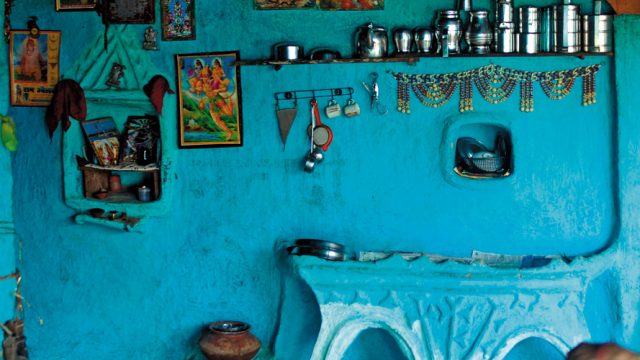The Village Safari, better known as the Bishnoi Safari, serves as an introduction to the Bishnoi sect, founded by Jambheshwarji. They follow a set of 29 (bis and noi) principles, which include several norms related to the protection of animals and conservation of trees. Most hotels and tour operators organise these safaris.
Usually, the first stop is the Bishnoi village of Khejarli (25 km south-east of Jodhpur). Khejarli is best known as the place where the precedent for the Chipko Movement was established. In 1730, the Maharaja of Jodhpur, Abhay Singh, ordered the cutting down of trees in and around Khejarli for the renovation of the Mehrangarh Fort. In protest, about 360 people, including women, from 84 Bishnoi villages wrapped themselves around the trees, in the hope that they would be able to save them. However, the maharaja’s armies ruthlessly went ahead and cut down the trees, along with the people clinging to them. Three hundred and sixty-three people died at that time and today, 363 trees have been planted around the Jambheshwarji Temple in their memory.

The safari then heads to the potters’ village of Singhasini (27 km). The potters here use clay and sawdust as raw material and it’s interesting to watch them at work. This is followed by halts at the shepherds’ village at Rebari and the Bishnoi village of Guda. Here you can enjoy tea and conversation with the women and the children of the village and take a peek into their mud houses whose interiors are cool even in the desert heat. There is something to learn from here about living in harmony with one’s surroundings; the villagers’ lives are environment- friendly — they use every scrap of waste, be it to decorate their homes or to make cots.
Not far from the Guda Bishnoi Village is the Guda Lake, a retreat for birds including the sarus and demoiselle cranes. Apart from blackbuck, nilgai and chinkaras, one may also get to see turtles in this area. The next stop is Kankani, which is known for lovely terracotta work and block printing. Here you can see how the block-printed cloth that Jodhpur is so famous for is crafted. Salawas, famous for its dhurries, is an obscurely located village, down a bumpy road that takes you nowhere else.
The Information
The Pukhraj Prajapat Dhurry Udyog (Tel: 0291- 2696744; Mobile: 09414720724; Email: chhotaramprajapat@rediffmail.com) here is known for its dhurries, priced at ₹1,500 and above. The Prajapats also run a homestay where you are put up in circular huts and served sumptuous Rajasthani meals. They can also take you on camel safaris (Website: salawashomestay.com. You can base yourself at Luni, Rohetgarh or Jhalamand if you want to go on a village safari. Fort Chanwa at Luni and Hotel Rohet Garh also give you the option of doing the safari by jeep or by horse. The Bishnoi Village Camp and Safari (Mobile: 09414129233, 09314716401; Tariff: ₹2,200, with breakfast) at Guda is also a good option




